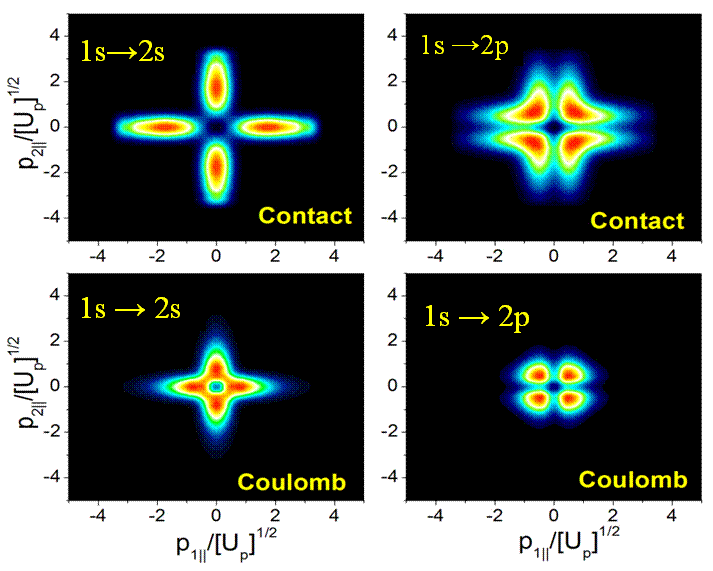 |
NSDI electron momentum distributions; from T. Shaaran, M.T. Nygren and C. Figueira de Morisson Faria, Phys. Rev. A 81, 063413 (2010) |
Laser-induced nonsequential ionization is a strong-field phenomenon for which electron-electron correlation is huge and cannot be ignored. In fact, "nonsequential" means that the double ionization transition amplitude cannot be described as the product of one-electron ionization processes, i.e., that, physically, both electrons interact with each other. This phenomenon has been first identified when a "knee-like" structure deviating in orders of magnitude from the predictions of sequential models, has been identified. Even stronger evidence for a nonsequential mechanism has been provided with the advent of the COLTRIMS technique, which allowed one to resolve the ion, or electron momentum distributions. These measurements revealed distributions peaked at nonvanishing momenta, which could be explained by a rescattering mechanism in which the first electron, upon return, provides the core with enough energy so that the second electron is released in the continuum. Similar features have been observed for triple, four- and fivefold ionization, which strongly hints at a nonsequential mechanism as well.
Our work on nonsequential double ionization addresses several aspects of this phenomenon, such as electron-electron dynamics, the rescattering mechanisms of electron-impact ionization (EI) and recollision with subsequent tunneling ionization (RESI), and their potential for attosecond imaging of atoms and molecules. This work has been developed analytically to a great extent employing the strong-field approximation and saddle-point methods, in collaboration with leading scientists in the field such as Wilhelm Becker (MBI-Berlin), Maciej Lewenstein (ICFO-Barcelona), Xiaojun Liu (Wuhan) and, more recently, by our group at UCL.
For details see our recent review article C. Figueira de Morisson Faria and X. Liu, "electron-electron correlation in strong laser fields".
Electron-impact ionization
Electron-impact ionization is a recollision mechanism in which the first electron provides its parent ion with enough energy for a second electron to overcome its second ionization potential and reach the continuum. Both electron leave at once and populate the first and third quadrant of the plane spanned by the momentum components parallel to the laser-field polarization. We have investigated this rescattering mechanism in detail, looking at the effect of final-state electron-electron repulsion, different types of interaction (contact vs long range) by which the second electron is dislodged, and different initial bound states on the electron-momentum distribution.
Furthermore, we have also shown that NSDI with few cycle driving pulses can also be used for diagnosing the carrier-envelope phase of such pulses. Our scheme has been experimentally realized in a joint effort involving the MBI-Berlin, the Technical University Vienna and the Max Planck Institut fuer Quantenoptik, Garching. More recently, we have investigated how to control NSDI by using polarization-gated pulses, and also quantum-interference effects in NSDI in molecules.
This work has been developed since 2004 in collaboration with Wilhelm Becker (MBI-Berlin), Henning Schomerus (Lancaster University), Maciej Lewenstein (ICFO-Barcelona), Anna Sanpera (Universidad Autonoma, Barcelona) and Xiaojun Liu (Chinese Academy of Sciences, Wuhan) and also by our group at UCL.
Attosecond thermalization
Upon return, the first electron can also provide the core with enough energy so that several electrons are freed. In this case, there may be several mechanisms by which this occur. We constructed a simplified statistical model in which we assumed that after collision of the first electron, it took a time Δtfor the energy to be redistributed. After this time, the electrons left. We have been able to infer a time delay of a few hundreds of attoseconds from existing experiments. These are the shortest thermalization times measured so far. We have also investigated the influence of different types of electron trajectories, or of hard vs glancing collisions in the thermalization process.
This work was developed in 2005-2007 in collaboration with Wilhelm Becker (MBI-Berlin), Paul Corkum (NRC-Ottawa), and Xiaojun Liu (Wuhan).
Recollision-excitation with subsequent ionization (RESI)
The first electron, upon return, may also promote a second electron to an excited state. After a time delay the second electron is then released in the continuum by tunneling ionization. This ionization mechanism is important for species such as argon, for molecular targets and also for not so high driving-field intensities, when electron-impact ionization is suppressed. This physical mechansim, however, is considerably less understood than electron-impact ionization, due to the fact that it is much harder to model.
We have performed some of the most comprehensive semi-analytic studies of the RESI mechanism. We have shown that this mechanism can be understood by a rescattered above-threshold-ionization-like process for the first electron followed by direct above-threshold ionization. We have used this fact to delimit kinematic constraints for this mechanism, which agreed with the computed electron-momentum distributions and show that, in contrast to what is commonly believed, the electron momentum distributions occupy the four quadrants of the plane spanned by the parallel electron momentum components. We have also shown that the RESI mechanism has potential imaging applications, due to the fact that the bound state to which the second electron is excited leaves a strong imprint on the electron-momentum distributions.
This work has been developed since 2008 at UCL in collaboration with Tahir Shaaran, Tom Nygren and Brad Augstein.